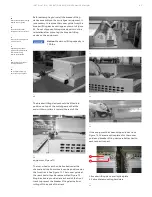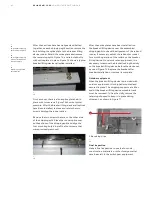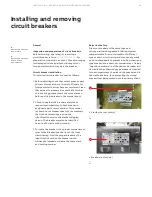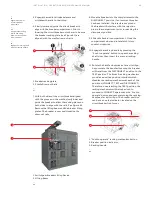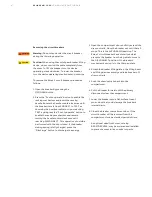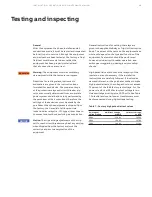
35
R E LI AG E A R® LV SG
LO W VO LTAG E S W I TC H G E A R
—
55
Plan view of neutral
bus splice installation
—
55
—
56
—
57
—
56
Rear view of main bus
at a shipping split
—
57
Plan view of a three bar
main bus connection
Neutral bus
The neutral bus may be insulated from the
grounded frame of the switchgear equipment;
thus, it is mounted on insulators throughout
the equipment.
Installation of the neutral bus splice plate across a
shipping split is similar to the ground bar splice
except that the splice plate is not bolted to the
equipment frame. Figure 55 illustrates the
installation of the neutral splice plate.
Horizontal main bus
The installation of the horizontal bus splice bars
is with bolted joints. Figures 56 and 57 illustrate the
assembly of the main bus splice plates on
the bolted bus system. Copper bus systems
are normally supplied with flat washers and
lock washers.
Figure 56 shows the rear view of the main bus area
with the installed splice plates indicated with
cross-hatching.
Figure 57 shows that a spacer is used both between
the bus bars when more than one bar is used per
phase (normally the 2000 A and larger main bus
ratings).
After assembly of the splice bars and spacers, the
1/2-13 bolts should be tightened to a torque of
35-40 ft-lbs. After completing the installation of
the main bus splice bars, the joint covers may be
mounted and secured by a 3/8-16 nylon bolt and
polyester flat washer if the bus insulation option
has been supplied with the equipment.
5. Connect the transformer secondary - The
connection of the transformer secondary to
the incoming bus bars in the transition is made
using the flexible connection straps supplied
with the transformer. These connections are
always bolted joints.
The recommended torque for tightening the ½-13
bolts fastening the transformer connection straps
to the incoming bus bars is 35-40 ftlbs.
6. Interconnect control wiring - Interconnection
of control wiring across shipping splits is
accomplished by connecting to terminal blocks
located in the cross-section wiring trough on top
of the equipment shown in Figure 58.
If terminal blocks are provided, each wire must
be attached to the correct point on the terminal
block, following the circuit identification number
attached to each wire.
Ethernet or other communication wiring is
connected by similar methods.






















